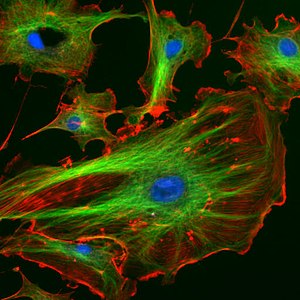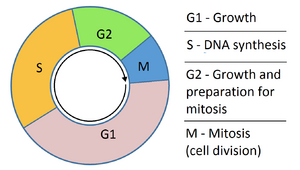Cell
The cell is the basic building block and functional unit of all multicellular organisms. It is equipped with two so-called basic cell compartments: the nucleus and the cytoplasm .
Cytoplasmic membrane structure[edit | edit source]
Animal cell Each cell has a cytoplasmic membrane , this biological membrane envelops the cell and membrane organelles . It consists of phospholipids , cholesterol , proteins and oligosaccharide chains that are covalently linked to phospholipids and proteins.
The cytoplasmic membrane is one of the most important parts of the cell because it has a number of functions. It delimits and delimits the cell, ensures selective permeability and regulation of the environment in the cell, recognizes cells by means of cell signaling and allows cell adhesion.
Membrane cell organelles[edit | edit source]
The membrane structures of the cell complete the boundaries of the cell and the intracellular regions. For these reasons, we sometimes refer to them as cell compartments.
Kernel
See the Cell Core page for more information .
Mitochondria contain enzymes that are involved in cellular respiration and ATP production . Simply put, cellular respiration takes place in such a way that glucose is converted by glycolysis to pyruvate, which is transferred to mitochondria , where it is oxidized to CO 2 and H 2 O in the Krebs cycle and the energy gain is accumulated in the form of ATP. These are elongated organelles with their own mitochondrial genome, which encodes part of the proteins.
The endoplasmic reticulum is a set of membranes in the cytoplasm that form an imaginary intricate network. The granular endoplasmic reticulum is present in every specialized cell for the secretion of proteins, such as pancreatic acin cells or fibroblasts. The agranular (smooth) endoplasmic reticulum differs from the granular reticulum in that it does not have polysomes attached to the membranes. It has important functions in the cell, such as phospholipid synthesis, regulation of calcium ions and detoxification of potentially harmful molecules.
The Golgi complex is usually located near the core. The most important functions of the Golgi complex include post-translational modifications of proteins (glycosylation, phosphorylation of proteins) and packaging of the product in membrane vesicles.
Lysosomes are the site of so-called intracellular digestion. They contain about 40 different hydrolytic enzymes. Lysosome-rich cells are, for example, hepatocytes, macrophages or proximal tubule cells in the kidney.
Peroxisomes are named after the enzymes that produce and degrade H 2 O 2 . They have a spherical shape. They are involved in the oxidation of fatty acids and the decomposition oxygen plays an important role in detoxifying the body (especially in the breakdown of alcohol in the liver and kidneys).
Melanosomes synthesize and store the pigment melanin , it is found in the skin (epidermis, hair follicles) and eye (iris, retina) type of melanocytes .
Non-membrane cell organelles[edit | edit source]
Cytoskeleton: actin filaments are marked in red, microtubules in green, nucleus in blue. Ribosomes are particles that form a small and a large subunit. They consist of ribosomal RNA and proteins. They are extremely important because they are involved in protein synthesis. Proteins that the cell usually uses itself (hemoglobin, actin or myosin) are formed on free ribosomes . The small subunit serves to collect all important components for translation ( mRNA , tRNA , amino acids , elongation factors). Large subunit helps form peptide bonds (serves as peptidyltransferase)
See the Translation page for more information .
The cytoskeleton forms a complex network of protein polymers in the cytoplasm, thus ensuring the cytoskeleton strengthens the cell. It consists of filaments , which we divide based on their diameter. Actin filaments (microfilaments) form a cortical network through the cytoplasmic membrane and, for example, the inner skeleton of microvilli ( 7 nm ). The intermediate (middle) filaments form a solid network anchored in desmosomes and hemidesmosomes, forming the lamina fibrosis of the nuclear envelope ( 10 nm ). The microtubules protrude from the microtubular organizational center to the edges of the cell, they are straight tubules ( 25 nm ).
Intercellular connections[edit | edit source]
Desmosome See the Cell Connections page for more information .
Adhesive connection (contact)
- Zonula adhaerens - band adhesive connection of lateral surfaces, clamps into actin filaments.
- Desmosome - a point anchor connection, clamps into intermediate filaments.
- Hemidesmosome - connection of the basal part of the cell with the extracellular matrix.
Tight junction
- Zonula occludens - connection around the perimeter of the cell, prevents paracellular diffusion.
Communication connection
- Nexus (gap junction) - allows selective diffusion of molecules and fast communication between neighboring cells.
Cell surface specialization[edit | edit source]
Free apical surface
- Microvilli - cytoplasmic protrusions, their dense complex forms a so-called brush border.
- Stereocilia - long immobile microlicles (eg in the middle ear ).
- Cilia - are elongated moving protrusions (eg in the fallopian tube ).
Basolateral surface
It participates in the cohesion of epithelial cells, including special intercellular connections and connections to the basement membrane (eg basal labyrinth ).
Cell life cycle[edit | edit source]
Cell cycle scheme See the Cell Cycle page for more information .
It is a set of morphological and biochemical processes in cells between their origin and division into two daughter cells.
Most cells have the ability to reproduce, with the exception of neurons or erythrocytes. The cell is created by division and disappears by further division. The cell cycle has four basic phases:
- G 1 phase - is the so-called presynthesis, cell growth, synthesis of RNA and proteins
- S phase - DNA synthesis, DNA replication (chromosomes formed by two chromatids)
- G 2 phase - RNA and protein (tubulin) synthesis takes place, energy is also formed and stored for subsequent mitotic division
- M phase ( mitosis ) - identical daughter cells with the same number of chromosomes and DNA content are formed
Cell death[edit | edit source]
Necrosis[edit | edit source]
Pathological process. It is caused by a bad toxic, mechanical or thermal effect. These effects disrupt the homeostasis of the cell (stability of its internal environment), which leads to dilatation of the endoplasmic reticulum , alteration of mitochondria , swelling of the cell, rupture of the plasma membrane and thus cell death.
See the Necrosis page for more information .
Apoptosis[edit | edit source]
Programmed cell death. Physiological process of cell death caused by activation of the p53 gene . It results in condensation of chromatin in the nucleus, segmentation of the nucleus, collapse of the plasma membrane and the formation of apoptotic bodies. These bodies are removed by phagocytosis . Apoptosis occurs upon activation of Ca 2+ -Mg 2+ dependent endonuclease. Subsequent degradation of nuclear genomic DNA into oligonucleosomal fragments leads to a decrease in RNA and protein synthesis .
See the Apoptosis page for more information .
Links[edit | edit source]
[edit | edit source]
- Cell nucleus
- Cell membrane
- Cell cycle
- Apoptosis
- Eukaryotic cell
- General mechanisms of cell damage
Reference[edit | edit source]
- ↑ MESCHER, Anthony. Junqueira's Basic Histology: Text and Atlas, Fourteenth Edition. - edition. McGraw-Hill Education, 2015. 1136 pp. ISBN 9780071842709 .
- ↑ NEČAS, Oldřich. General biology for medical schools. 3rd edition. Jinočany: H & H, 2000. ISBN 80-86022-46-3 .
References[edit | edit source]
- LÜLLMANN-RAUCH, Renate. Histology. 3rd edition. Prague: Grada, 2012. 576 pp. ISBN 978-80-247-3729-4 .
- JUNQUEIRA, L., Robert KELLEY and José CARNEIRO. Basics of histology. - edition. H + H, 1997. 502 pp. ISBN 9788085787375 .
- OTOVÁ, Berta, et al. Medical Biology and Genetics Part I. 1st edition. Prague: Karolinum, 2008. 123 pp. ISBN 978-80-246-1594-3 .
- MESCHER, Anthony. Junqueira's Basic Histology: Text and Atlas, Fourteenth Edition. - edition. McGraw-Hill Education, 2015. 1136 pp. ISBN 9780071842709 .


